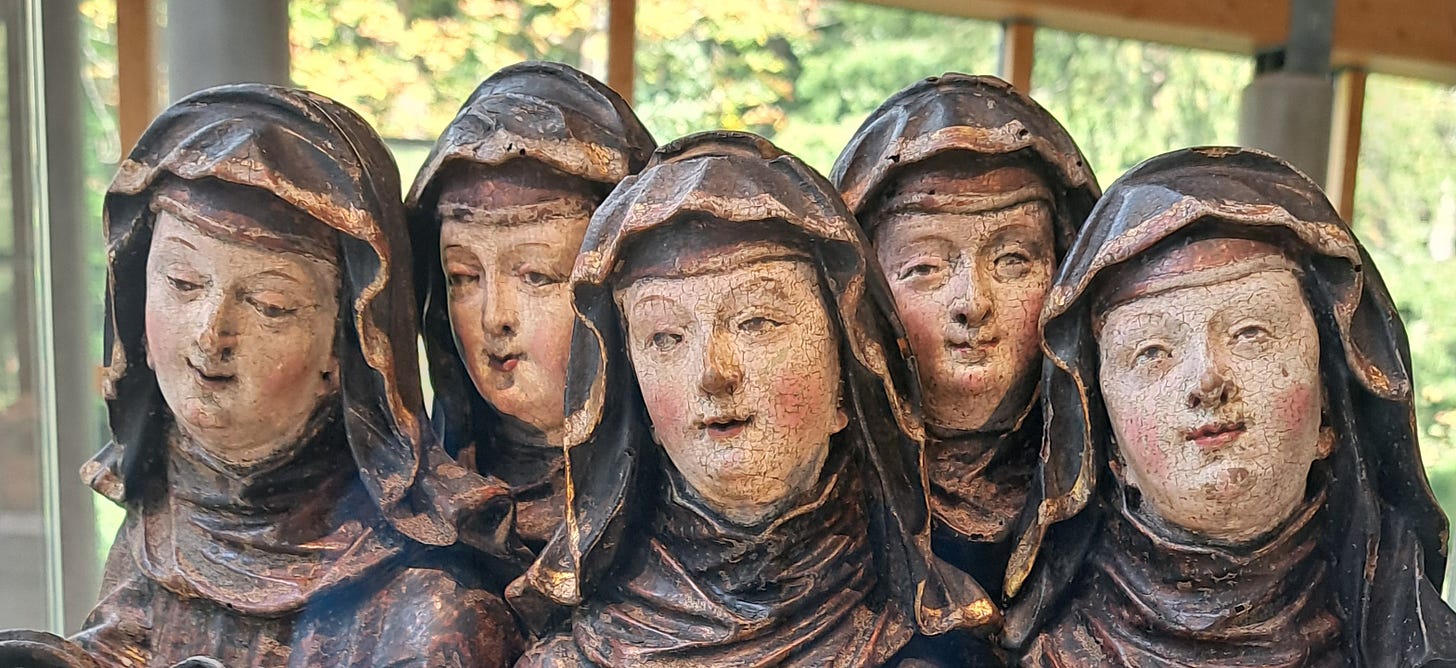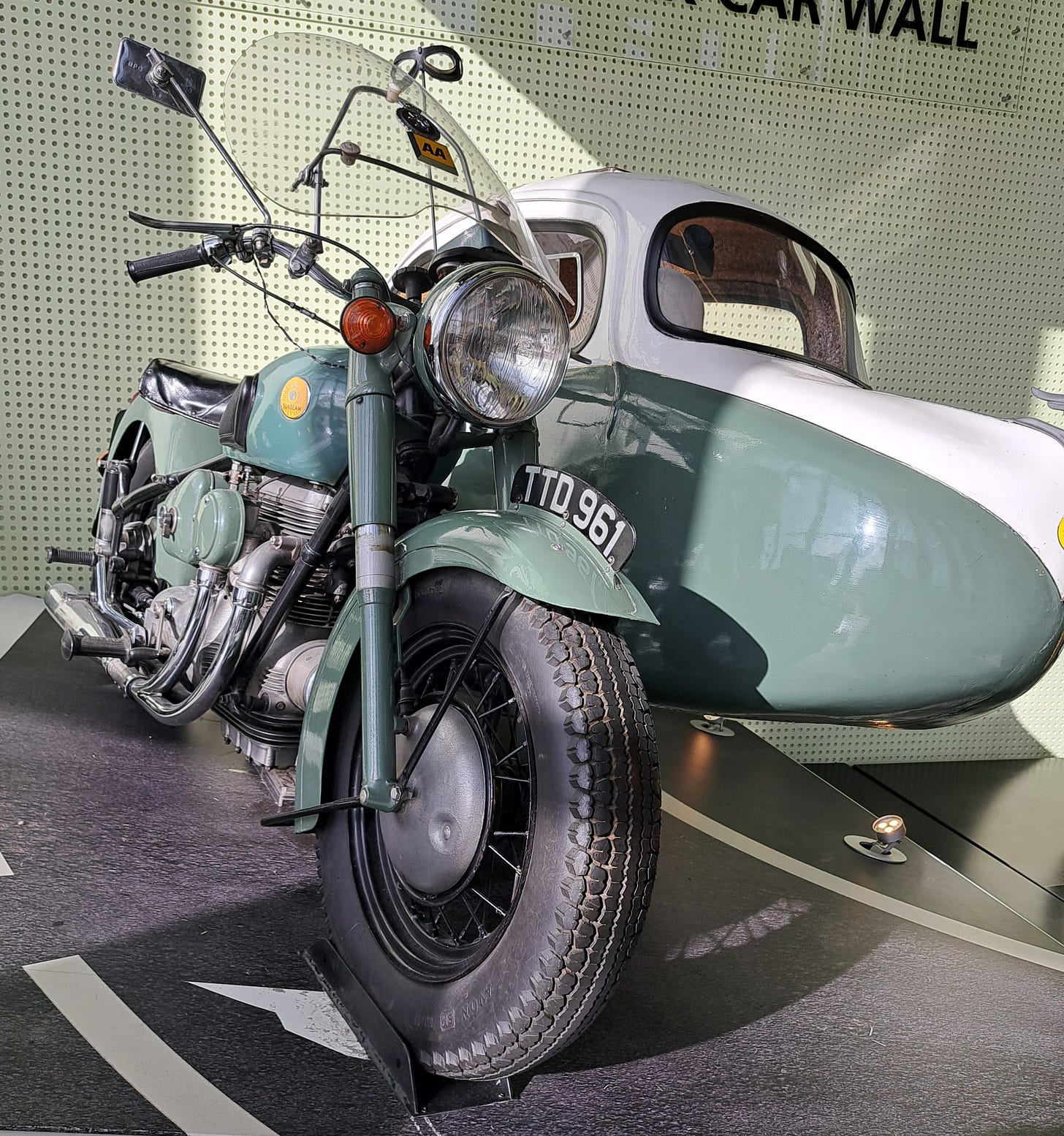I get a Glasgow Kiss of Culture....
......and I am still reeling after a long weekend in Scotland's City of Empire
True to my self-indulgent mission of writing about whatever catches my eye, I have been reflecting on a long weekend spent wandering around the corridors of culture in Britain’s glorious City of Empire - Glasgow. And the highlight wasn’t what I had expected it to be.
Glasgow proved a real eye-opener - although I probably wouldn’t have found most of its glories if I hadn’t been part of an organised visit. So let me credit the two organisations which were responsible for the opportunity - the Art Fund and ASLEF.
The weekend was mostly curated by the remarkable Art Fund, our national charity for the financial support of art. In these days of national self-denigration, Art Fund is something we ought to be very proud of - 120 years old and during that time the saviour of countless art treasures and friend of many museums and galleries. My wife and I have modestly supported their work for several years and if you felt like doing the same, I promise it will bring you joy.
I’m not feeling quite as warm towards ASLEF, but credit where it is due. If their strike hadn’t cancelled our planned train home, we wouldn’t have stayed the extra day which really topped off our weekend. Not that I am opposed to trade unions (do you want to see my collection of annual membership cards from when I was was a stroppy little NUJ firebrand?) or to train drivers being rewarded as aristocrats of industry, which I am sure they are.
Back to the galleries - (don’t get distracted by the motor-cycle photograph, I’ll come to that in a while.) Despite a ruinous recent history of fire loss through TWO devastating blazes in only five years at Glasgow’s irreplaceable Mackintosh building in the School of Art, Glasgow is truly blessed with cultural assets. For me the Koh-i-Nor in the City’s cultural crown is Kelvingrove Art Gallery and Museum, dominating Argyle Street like a palace of the Raj or the Parliament of some far-away Dominion. It’s not just extraordinary in appearance, this is a building which fulfills the true purpose of art and conservation. There are PEOPLE in it. Local people. Real, live, noisy, excited people. People who have heard art is important and want to know why - and to show their kids the paintings and exhibits which excited them when Mam and Dad brought them here, a generation ago.
Kelvingrove is a rock star of a museum. And as if to emphasise the point, at 1pm every day, having dazzled visiting eyes with everything from “Sir Roger” the stuffed elephant (with a full-size Spitfire suspended overhead) to the colourful exhibits from India and Ghana, the rolling thunder of the museum’s enormous 2,899 pipe organ brings the crowds streaming out of the galleries. They sit, perch, lean or just lie flat out on the floor of the main entrance hall to hear a free 20 minute concert beloved of generations of Glaswegians. This is not just some bright PR idea dreamed up yesterday, Kelvingrove has been shuddering to this sound every day for so long that it’s now the longest-running series of free organ concerts in the world. Our organist of the day, Fraser Pearce (a local lad whose wife’s grannie used to be a cleaner here in 1930) booms out Elgar, Bach and Tchaikovsky and between the pieces bobs out of his seat waving his thanks for the cheers and applause of crowd below. This is joyful Art in Action!
If you’d like a brief taste of what Fraser can do with three manuals and nearly 3,000 pipes there’s a YouTube link below.
Things are much more tranquil over at Pollock Country Park, in the very recently re-opened Burrell Collection. It’s set in parkland just outside the City but with easy access by local train and then a free bus from the station to the Burrell’s front door. (We decided to walk across the park - big mistake. Let the bus take the strain and wear yourself out in the galleries). It may be more peaceful than the Kelvingrove, but in a quiet way I found the Burrell just as inspiring.
Like much of Glasgow, the Burrell has had a turbulent history. The collection isn’t particularly Scottish, it was assembled by Sir William and Lady Constance Burrell, a very wealthy couple who made their money from shipping and were then boosted into the super-rich category by the fortunes of war. They were made an extraordinarily generous offer for their whole shipping fleet by the Australian Government, which needed an instant Merchant Navy as WW1 loomed. Overnight they found themselves with more money than they could conceivably need in a life-time and so indulged themselves by amassing 9,000 items of art and artefacts.
When it came to finding a permanent home for the collection, Glasgow was lucky to get a look-in. The Burrells certainly didn’t intend the collection to be housed in Glasgow or even Scotland. They had loaned the Kelvingrove some of their art, but it was the Westminster government they wooed with a plan to gift their entire collection. The Burrells wanted it to be in London and to rank alongside other “national” collections. By this time WW2 was on the horizon, so Whitehall had more pressing concerns and declined - only for the pushy Burrells to make the same offer to the London County Council. Again, despite protracted discussions, the gift was eventually spurned.
Glasgow was their Secondhand Rose, but again the wooing was long and difficult. The Burrells had highly specific requirements for any chosen site and this extraordinary collection remained crated and stored from 1944 until the mid-sixties, when Pollock Park came under the control of the City and the construction of a museum to house Burrell’s collection got under way.
Glaswegians apparently love the building and it has certainly won a host of awards. But architecture, as King Charles will tell you, is very much a matter of personal preference. The Burrell building, with its high stone walls set against a wooded backdrop doesn’t do anything for me. Contrasted with the joyful extravagance of Kelvingrove, to my eye the dour Burrell looks like it came from a catalogue of designs of medium security units for the Scottish Prison Service.
But do NOT give up hope all ye who enter here - inside it is a revelation. Although it was first opened in 1983 the Burrell has recently undergone a huge re-hang and re-design. Issues with the ‘80s building meant it required a £33m repair job, so the museum authorities took advantage of the necessary years of closure to spend a matching sum on the collection and displays. What they have achieved is a major leap forward in museum explanation and display - a truly innovative and inspired use of digital techniques, which should be capable of capturing the imagination of the smartphone generation.
This year the Burrell won Art Fund’s Museum of the Year title and when I saw the video reports of the finalists at the Award ceremony, I admit I was hard-pressed to understand why the judges put it ahead of such an excellent short-list. Walking round the Burrell, all becomes clear. It isn’t the collection which makes the Burrell so exceptional, it’s the way it has been managed, curated, presented and explained. It is massive, but it has clarity. It is learned, but alluring. I didn’t see it coming - and it hit me right on the nose! Going digital should be a higher priority for all collections - see just one example (below) of the way the Burrell has digitised a ceramics display.
And now, thanks to ASLEF, we move on to our extra day. I haven’t even mentioned the captivating recreation of Charles Rennie Mackintosh’s house at the Hunterian Museum in Glasgow University, or the enfolding intimacy of the inspiring Glasgow Women’s Library, which were both part of the Art Fund agenda. They each made a impact on me, but I am keen to gallop on to another of the major cultural assets of Glasgow.
Nothing speaks to me more powerfully of Glasgow’s 21st century personality - and self-confidence - than the Riverside Museum, a striking Zaha Hadid building constructed only a few years ago on the site of a Glasgow shipyard which launched more than 500 vessels before falling silent during the city’s industrial collapse. Today Glasgow’s harbour regeneration area is crisp, clean and cool - with plenty of potential to match what port cities like London, Vancouver or Sydney have achieved. Riverside is exactly the anchor development the area needed to build a new tomorrow, while honouring the past. And what a past. Glasgow was truly the Workshop of the World. The infrastructure of nations was fashioned here and that’s what this £75m museum is here to tell us.
So, finally, we get to the motor cycle and sidecar - and to locomotives, ships, lorries, boilers, engines, telegraphs….the whole paraphernalia of productivity which built nations. Some of the presentation is inspired. Riverside now has a huge collection of ship models which were once at Kelvingrove where they were laid out in rows. Here the ships come to you, drifting by as you sit on a bench, transported on what looks for all the world like an enormous Yo Sushi conveyor. A TV monitor displays the facts and figures of each ship as it passes. How clever!
I wandered wide-eyed round the other galleries for, to me, there is as much beauty, skill and human endeavour on display in Glasgow’s transport collection as ever William Burrell hauled back from the sites of the ancient world and the art houses of Europe.
The hard men of Govan and the Gorbals used to talk about a Glasgow Kiss - a head-butt to the face which usually broke an opponents’ nose. Not an experience to be found here much these days, I trust, but this is still a knock-out of a city!
Foodie footnote. I’m not a restaurant critic, but Sarah and I so much enjoyed the Art Fund’s lunch-time trip to one of Glasgow’s Italian restaurants (the Glasgow/Italian relationship is a huge cultural saga for another time) that we booked for dinner on our extra night. If we’d had Stanley Tucci with us he’d have been saying…"Oh…my…..G A R D…”. Gloriosa, Argyle St (https://www.gloriosaglasgow.com/).
Artie footnote: If you feel inspired by what you have read, find out more about the Art Fund at https://www.artfund.org/







I went nce to the Burell Collection during a cold winter. The snow was surrounding the building. It was beautiful. Like being in a warm cocoon and in a bath of snow at the same time.
Thanks. Appreciate your comments! The Hadid building is not just striking, it really works as a museum.